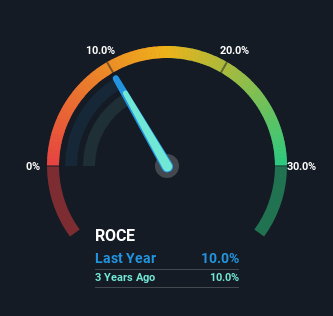- South Korea
- /
- Basic Materials
- /
- KOSDAQ:A225530
Bokwang Industry (KOSDAQ:225530) Has Some Way To Go To Become A Multi-Bagger
If you're looking for a multi-bagger, there's a few things to keep an eye out for. Amongst other things, we'll want to see two things; firstly, a growing return on capital employed (ROCE) and secondly, an expansion in the company's amount of capital employed. Put simply, these types of businesses are compounding machines, meaning they are continually reinvesting their earnings at ever-higher rates of return. In light of that, when we looked at Bokwang Industry (KOSDAQ:225530) and its ROCE trend, we weren't exactly thrilled.
What Is Return On Capital Employed (ROCE)?
Just to clarify if you're unsure, ROCE is a metric for evaluating how much pre-tax income (in percentage terms) a company earns on the capital invested in its business. The formula for this calculation on Bokwang Industry is:
Return on Capital Employed = Earnings Before Interest and Tax (EBIT) ÷ (Total Assets - Current Liabilities)
0.10 = ₩14b ÷ (₩183b - ₩42b) (Based on the trailing twelve months to June 2024).
Therefore, Bokwang Industry has an ROCE of 10.0%. On its own, that's a low figure but it's around the 9.1% average generated by the Basic Materials industry.
View our latest analysis for Bokwang Industry

Historical performance is a great place to start when researching a stock so above you can see the gauge for Bokwang Industry's ROCE against it's prior returns. If you want to delve into the historical earnings , check out these free graphs detailing revenue and cash flow performance of Bokwang Industry.
What The Trend Of ROCE Can Tell Us
There are better returns on capital out there than what we're seeing at Bokwang Industry. Over the past four years, ROCE has remained relatively flat at around 10.0% and the business has deployed 46% more capital into its operations. Given the company has increased the amount of capital employed, it appears the investments that have been made simply don't provide a high return on capital.
What We Can Learn From Bokwang Industry's ROCE
As we've seen above, Bokwang Industry's returns on capital haven't increased but it is reinvesting in the business. Unsurprisingly, the stock has only gained 5.5% over the last five years, which potentially indicates that investors are accounting for this going forward. Therefore, if you're looking for a multi-bagger, we'd propose looking at other options.
Bokwang Industry does have some risks though, and we've spotted 1 warning sign for Bokwang Industry that you might be interested in.
For those who like to invest in solid companies, check out this free list of companies with solid balance sheets and high returns on equity.
Valuation is complex, but we're here to simplify it.
Discover if HC BoKwang IndustryLtd might be undervalued or overvalued with our detailed analysis, featuring fair value estimates, potential risks, dividends, insider trades, and its financial condition.
Access Free AnalysisHave feedback on this article? Concerned about the content? Get in touch with us directly. Alternatively, email editorial-team (at) simplywallst.com.
This article by Simply Wall St is general in nature. We provide commentary based on historical data and analyst forecasts only using an unbiased methodology and our articles are not intended to be financial advice. It does not constitute a recommendation to buy or sell any stock, and does not take account of your objectives, or your financial situation. We aim to bring you long-term focused analysis driven by fundamental data. Note that our analysis may not factor in the latest price-sensitive company announcements or qualitative material. Simply Wall St has no position in any stocks mentioned.
About KOSDAQ:A225530
HC BoKwang IndustryLtd
Manufactures and sells aggregates, ascons, and ready mixed concrete in South Korea.
Slight risk with mediocre balance sheet.
Market Insights
Community Narratives



